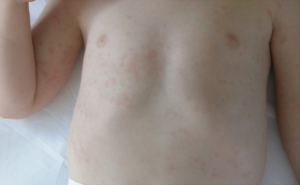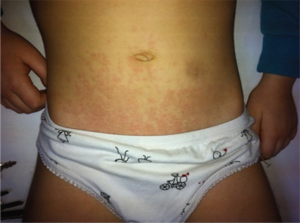
Definisjon
Systemisk barneleddgikt / systemisk JIA kalles også Stills sykdom hos barn og preges av høye febertopper over tid, uten infeksjon. Varierende lyse-rødt utslett som følger febertoppene og leddbetennelser i forløpet er vanlig. Sykdommen har fellestrekk med de periodiske febersyndromene (autoinflammatoriske sykdommer), men regnes som en form for barneleddgikt (juvenil idiopatisk artritt, JIA) sammen med oligoartikulær-, polyartikulær- og entesitt-relatert barneleddgikt.
Forekomst
Systemisk barneleddgikt utgjør 10% av alle JIA og forekommer like hyppig blant jenter som gutter, oftest blant små barn i 2 – 4 års alder, men alle aldersgrupper kan angripes. Det finnes også en voksen form (Adult Stills sykdom).
Symptomer

Febertopper. Daglige febertopper på mer enn 39 grader og varighet over minst 2 uker (uten effekt av eventuelle antibiotikakurer). Barna er ofte svært medtatte under feberen. Normal kroppstemperatur mellom feberepisodene («spiking fever»), selv uten febernedsettende legemidler.
Utslett. Et lyserødt (”lakse-rødt farget”) utslett kan følge febertoppene.
Lymfeknuter. Forstørrede (hovne) lymfeknuter, stor lever og milt forekommer.
Leddbetennelse (artritt) i ett eller flere ledd (knær, håndledd, ankler, fingre, nakke eller hofter) er vanlig etter hvert i sykdomsforløpet. Ved tidlig, effektiv behandling kan leddbetennelser unngår.
Andre. Noen barn får betennelse i hjerteposen (perikarditt), i lungehinner (pleuritt) eller i bukhinner (peritonitt) uten at bakterier eller annen infeksjon foreligger.
Undersøkelser

Sykehistorien kartlegger aktuelle symptomer (se ovenfor). Symptomdebut og alder ved start. Feber-forløp: febertopper avløst av normale verdier uten bruk av febernedsettende legemidler. Flyktig utslett (erythem) og artritt i forløpet. Infeksjonstegn og andre årsaker til feber (differensialdiagnoser) etterspørres også.
Klinisk undersøkes systematisk i henhold til rutiner for barn. Kroppstemperatur måles, hud, ledd, lymfeknuter, milt, lever, hjerte, lunger undersøkes. Antall angrepne ledd med lokalisering noteres.
Blodprøver. Betennelsesprøver (CRP, SR) er forhøyet. Også økt antall hvite blodlegemer (leukocytter) op til 20-30.000/mm3 er ikke uvanlig. Også høy ferritin forventes. Blodkulturer tas ved høy feber dersom det er mistanke om infeksjon og uklar diagnose. Immunologiske tester / antistoff forventes ikke å slå ut.
Leddvæske. Ved uklar diagnose med leddbetennelse, kan undersøkelse av leddvæske utelukke infeksjon ved mikroskopi, dyrkning og PCR-undersøkelser.
Bildediagnostikk. Vurdering av lungene med røntgen kan utelukke sykdomstegn i lunger. Ved ultralyd kan ledd, hjerte (ekkokardiografi) og lungehinner vurderes.
Vevsprøve (biopsi). Ved uklar diagnose kan benmargsundersøkelse være aktuelt.
Makrofag Aktiverings-Syndrom (MAS)
Makrofag Aktiverings-Syndrom (MAS) er en alvorlig komplikasjon som oppstår hos ca. 10% av barna med systemisk JIA. Utløsende er ofte en virusinfeksjon, særlig Epstein-Barr virus (EBV). Symptomer på MAS er vedvarende høy feber med dårlig allmenntilstand, påvirket hjernefunksjon, stor lever og milt, hovne lymfeknuter. Typiske forandringer i blodprøver er øning i leverenzymer (ALAT, ASAT, LD), oftest over 2-3 x øvre referanse-områder, triglycerider (fettstoffer), ferritin (oftest >1500), men lavere senkningsreaksjon (SR), men ofte moderat over referanse-området.
Lignende tilstander/ differensialdiagnoser ved systemisk JIA
Ved sykdomsdebut er ingen sikker diagnose mulig. En må utelukke andre former for barneleddgikt. bakterie- eller virusinfeksjon, malignitet (leukemi) og andre revmatiske sykdommer (Kawasaki sykdom, revmatisk feber). Ved mulig eksponering må også malaria vurderes.
Behandling av systemisk JIA
Mot symptomer er det vanlig å gi NSAIDs som naproksen eller ibuprofen, men disse er sjelden tilstrekkelig. Vanligvis foreligger behov for mer effektive, biologiske medikamenter i form av interleukin-1 hemmere som anakinra (Kineret), canakinumab (Ilaris) eller IL-6 hemmer (tocilizumab). Disse har nesten umiddelbar god effekt hos de aller fleste. Behovet for prednisolon (et kortison) eller metotreksat som ble mye brukt tidligere, er da lite. Ved mistanke om MAS (se ovenfor) kreves tett overvåkning, og ofte suppleres blant annet med glukokortikoider i høye doser intravenøst.
Prognose
Helbredende behandling foreligger ikke, men i mange tilfeller stanser sykdommen av seg selv. Enkelte har bare en periode med aktiv sykdom, mens andre har tilbakevendende episoder (sykdomsvarighet fra få uker til mange år). Et mindre typisk forløp er preget av kronisk leddbetennelse (artritt) som da behandles som ved oligoartikulær- eller polyartikulær barneleddgikt.
Litteratur
Barn med Revmatisk sykdom, BINDEVEVSSYKDOMMER.no

